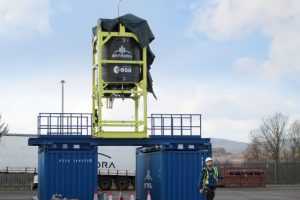The ESA and the Estonian Space Office aim to make “space technology more secure and accessible for companies across Europe”.
“Over the past five years, there has been a significant increase in cyberattacks, emphasising the growing risks for sectors such as energy grids, emergency responders, and other critical infrastructure dependent on satellite connectivity,” said Laurent Jaffart, ESA Director of Connectivity and Secure Communications.
“Estonia’s proven leadership in cybersecurity makes it the ideal home for this facility. This initiative will improve cybersecurity knowledge across the sector and help elevate Europe’s digital future.”
Christophe Allemand, ESA’s Head of Space Systems for Safety and Security, also highlighted the space sector’s needs:
“This cyber range provides the practical testing environment our space sector needs. Companies can conduct critical security exercises, validate their satellite systems before launch, and gain the expertise needed to protect their space assets. This is essential infrastructure for building secure, resilient space systems.”
Space Cyber Range
Note that it will be a virtual environment – a data centre with dedicated servers and support equipment – enabling remote access.
Basically, it aims to be a sophisticated simulator where companies can create virtual copies of their satellites and systems. It will enable them to check for security weaknesses and practice responding to cyberattacks. This is before launching real hardware into orbit.
Estonia is already home to NATO’s cyber defence centre. And the new space cyber range will be established at Foundation CR14, Estonia’s existing national cyber range facility.
Testing
The platform will support official testing, validation, and certification processes. For example it will support penetration testing, reliability testing and recovery processes.
It will also be a centre for team-based or individual cybersecurity training. According to the ESA it will have “the flexibility to run on various hosting environments, including private hardware, hosted environments, public clouds, or qualified third-party platforms”.
Knowledge sharing and networking will be in the form of providing publications, demos and manuals.
It is aimed at small and medium-sized enterprises.
Consortium
Estonian companies were invited to submit proposals for concepts last year. And now a contract has been signed with a consortium led by Spaceit to begin development.
The Spaceit consortium that includes CybExer, CGI Eesti, and the University of Tartu.
The agreement was signed in Tallinn by Laurent Jaffart, ESA’s Director of Connectivity and Secure Communications (right) and Silver Lodi, Management Board Member of Spaceit (left).
The two-year project is supported by ESA’s Advanced Research in Telecommunications Systems (ARTES) programme line. Finding is to the tune of more than €2.5 million.
e-Estonia
Estonia joined the ESA in 2015. And last year it signed Nasa’s Artemis Accords for future lunar and Mars exploration.
Once dubbed e-Estonia, it is considered one of the most advanced digital societies. It provides nearly all public services online. For example it has a digital identity card system, supports online voting, and reportedly 99% of bank transfers are made electronically.
Image: Estonian Space Office
See also: Floreat Estonia

